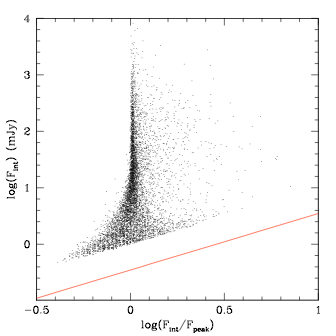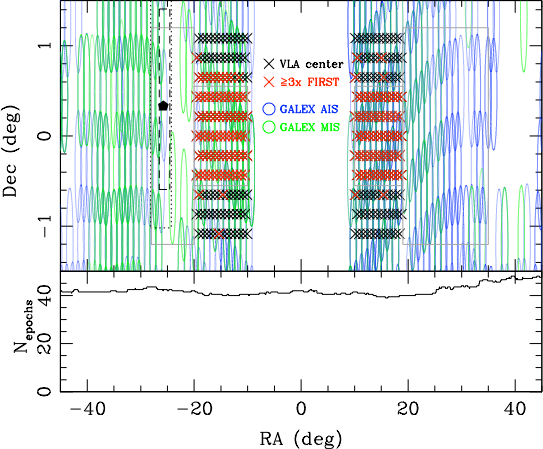What is Stripe 82?

Stripe 82 is the region on the celestial equator that the Sloan Digital Sky Survey (SDSS) has imaged over 10 times, giving coadded optical data 2 times deeper than single epoch SDSS observations. We have performed 20 cm radio observations using the Very Large Array (VLA) in the same area of the sky that probes three times deeper than the FIRST (Faint Images of the Radio Sky at 20 cm) survey to a median rms noise of 52 microJy/beam.
Where can You Find Radio Images of Stripe 82?
On the internet, of course. Here you can extract radio image cutouts for Stripe 82 and compare these deeper images to corresponding regions imaged by FIRST. Just type in your desired coordinates and push the “Extract the Cutout” button.
NEWS
Above is an example of what is available at the Stripe 82 Radio Image Extraction website located at:
http://third.ucllnl.org/cgi-bin/stripe82cutout.
The improvement in resolution and decrease in noise of Stripe 82 (left) over FIRST (right) is apparent in the cutouts above. Not only has the point source located at (0,0) in the FIRST image been resolved as two point sources with Stripe 82, the RMS noise in the radio data has been cut in half!
-
✦Finalized Stripe 82 Catalog Available!
A complete Stripe 82 catalog containing deep optical and radio data is available now!!!
For more detailed information regarding the technical design, observations, data reduction,
source extractions, column definitions, image analysis, completeness, optical identifications, and
survey characteristics of the Stripe 82 radio survey, please refer to Hodge et al. 2011.
-
✦Find Stripe 82 radio sources in the vicinity of your favorite RA and Dec. HERE!
-
✦Radio Image Cutouts Available Now!
SUMMARY
How Can you conveniently search the stripe 82 radio catalog?
Simply access the search page here, enter your desired coordinates and search radius, choose your preferred output format, and click “Search the Catalog”!
We aim to explain why there exists a dichotomy between “radio-loud” (about 1 Jy fluxes or greater) and “radio-quiet” (about 100 microJy fluxes or smaller) active galactic nuclei (i.e. why are there so few “radio-intermediate” active galactic nuclei observed?)
Left: Radio luminosity v. redshift. The dashed line indicates a division between radio-loud and radio quiet quasars according to the radio luminosity (e.g., Goldschmidt et al. 1999). The depth of our VLA data (as indicated by the red line) allows us to push the redshift limit of radio-loud completeness from z = 2.7 to z > 4.
Right: Radio loudness (as measured by the ratio of radio to optical flux) v. i-band magnitude. The solid red line shows the improvement that results from out deep VLA data. Combined with deep SDSS data, we can study most radio loud objects to an i of about 23.


Log of the integrated flux density v. log of the ratio of the integrated to peak flux densities (both taken at 20 cm). Values larger than about 0.1 indicate a resolved radio source. Shown are all spectroscopically confirmed SDSS quasars matched to the FIRST catalog (which is limited to 1 mJy). The red line indicates the gain that comes from pushing the radio depth to three times the FIRST depth.
Why Stripe 82?
SDSS primarily scans the northern galactic cap, but when this region of the sky is not observable, about 300 deg2 of sky on the celestial equator is repeatedly scanned giving a much deeper visible survey of this area known as Stripe 82.
WhAt are our aims in studying stripe 82?
Radio-Loud v. Radio-Quiet Dichotomy
Also, it has been proposed that the radio properties of active galactic nuclei depend of their redshift and luminosity, but this dependence may be hidden by the degeneracy between redshift and luminosity in a flux limited survey. In order to tease out this degeneracy, much fainter quasars over the largest redshift range possible must be measured, and this can be accomplished by combining our deep optical and radio data sets in Stripe 82.

Top: Arial coverage of deep VLA pointings in SDSS Stripe 82 as outlined by our existing deep (up to three times as deep as FIRST) VLA coverage (black x’s). Some VLA fields have even deeper coverage (red x’s). Only plate centers are marked; all of the VLA fields overlap to provide a contiguous area. Also shown are GALEX AIS (blue circles) and MIS (green circles) observations (excluding the ecliptic [RA (deg) around 0] region). Dashed/dotted lines near RA (deg) = -25 show existing CFHT and VVDS coverage; the black pentagon indicates the center of a deep (DXS) UKIDSS field (about 8 square-degrees). New VLA observations will extend leftwards from the 23 hr (-15 deg) field and rightwards from the 1 hr (15 deg) field as indicated by the grey boxes. Two additional grey boxes indicate the regions where we seek added depth.
Bottom: Number of epochs of SDSS data along Stripe 82. There are now actually more than 60 on average.
Data currently exists from the region of Stripe 82 in a number of different wavelength regimes. By combining data from the existing FIRST survey, ACT, UKIDSS, and the SDSS main survey with our proposed VLA imaging of Stripe 82, the best possible combined legacy data set can be compiled for one region of the sky.

Tick marks indicate the depths of the FIRST survey, our proposed VLA imaging of Stripe 82, ACT, UKIDSS, and the SDSS main survey. The solid black curves show the mean radio-loud quasar at z = 1. The top curve is normalized to the SDSS main survey limits and shows that the limits of FIRST and ACT are well-matched to this. The bottom curve demonstrates the 20 cm depth needed to match the deeper SDSS imaging in Stripe 82. The VISTA survey will provide deep near-IR data.
AGN Feedback and the Growth of Galaxies
With the FIRST and NRAO VLA Sky surveys conducted on the VLA, more and more “radio-intermediate” sources have been discovered. Could the dichotomy have arisen merely because of insufficiently deep radio surveys? Our project aims to test this possibility.
Arguments have been proposed asserting that the formation of massive galaxies is a self-regulating process, whereby active accretion of material onto central supermassive black holes results in enough kinetic and radiative energy being dumped into the system to prevent both star formation and further black hole growth. If the active stage of a galaxy plays a significant role in the evolution of the galaxy (and its environment), what part of that role is due to radio-emitting processes?
One of the key diagnostics of this process is the quasar luminosity function (QLF). Self-consistent models of the QLF can be made that explains the QLF shape in the optical, near-IR, soft X-ray, and hard X-ray, but it has been difficult to tie in the radio QLF because the radio QLF suffers from being limited to rather bright flat-spectrum sources. With our deep and expansive radio data in Stripe 82, the radio QLF can be determined to redshift and luminosity limits that have hitherto been impossible to achieve.
Area and 20 cm depth of the FIRST and COSMOS surveys in comparison with our proposed observations. VLA coverage of about 100 square-degrees of SDSS Stripe 82 fills and existing gap in the coverage plane. Indeed, covering the entire 300 square-degree field would complete a linear trend.

Who is working on
stripe 82?
Gordon Richards (Drexel University)
jhodge@student.physics.ucdavis.edu
This material is based upon work supported by the National Science Foundation under Grant Number 1108798. Any opinions, findings, and conclusions or recommendations expressed in this material are those of the author(s) and do not necessarily reflect the views of the National Science Foundation.
